



![]()
| Hello Children,
Another year is coming to an end and it's Christmas time once again. That fun time of the year, with loads of goodies, gifts and parties. But is this really Christmas? Christmas is the birth of Jesus, a gift to mankind from God. So we too should do our best to make the lives of those less fortunate than us happy. Make a resolution to give a better Christmas to the needy, to orphaned children. You can save up your pocket money and put a smile on their faces by giving them a gift. Make your own Christmas cards and give a personal touch to your cards, to show them that someone out there cares about them this festive season. Until next week Aunty Sunshine |
OH! the poor people......
Who are working in the 'workhouses'.....
In it was a little angry boy......
Called "Oliver Twist".....
He worked with poor children.....
Who were born to poor mothers......
Thus they lived.....
Making tables, chairs and sacks.....
To the government offices.
But they never got any money.
And were given a limited amount of food.
A cup of 'Gruel' only once.....
"Please, sir. I want some more"
Hungry 'Oliver Twist' said one day.....
But he never got any more.
Charles Dickens ..... wrote this book.....
Many years ago.
But there are poor people in this world today .....
Just like "Oliver Twist" in that day.....
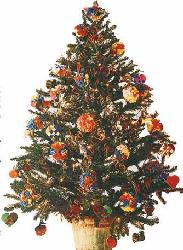
Tinsel tufts
Cut 1cm tufts off lengths of bright tinsel. Perch on the ends of branches to glitter like little mirrors as they reflect the Christmas- tree lights.
Dazzling hearts
Choose the brightest, metallic, wrapping papers you can find for making paper hearts. Combine reds and pinks, violets and oranges, and greens and blues to achieve a riotous colour scheme.
Flashy spheres
Lightweight and inexpensive, tissue balls are simple to make. They are also showy with their mixed frills of the brightest colours.
Red-hot chains
Wear rubber gloves to string chillis, as the juice can sting. The effort is well worth it, for they look enchanting among the branches.
Paper chains
1. Choose 2 different sheets of silver wrapping paper and glue them back to back, so that the attractive sides show. Cut the paper into 2cm strips.
2. Attach a piece of double-sided sticky tape to one end of each paper strip. Make a loop with a single twist. Thread each through the previous loop to a make a chain.
Silvered pine cones
1. Bend a length of florist's wire around a pine.
cone, near its base, leaving one end to secure cone to tree.
2. Twist the wire tightly around the cone to secure. Spray the cone with silver paint. While the paint is still wet, sprinkle with silver glitter. Do this job outdoors, preferably spraying into an old box.
Paper-heart template:
Enlarge the template to required size. Cut out. Tape to the wrong side of a sheet of metallic paper. Cut around the shape. Tape the shape to another colour of metallic paper and cut out a second piece. Remove template.
Tissue Balls

1. Place three 51cm x 38cm rectangles of tissue paper on top of each other.
Roughly pleat, gathering paper with thump and 2 fingers of each hand.
Repeat with 3 more pieces of tissue paper. 
2. Twist and scrunch pleated papers. Pull them straight. Cut each into 13cm lengths with scis sors or pinking shears.
 3.
Take 5 lenghts, and tie around middle with thread. Make a loop for hanging.
Separate and tease out.
3.
Take 5 lenghts, and tie around middle with thread. Make a loop for hanging.
Separate and tease out.

Paper hearts
1. Use the template (above ) to cut out 2 shapes from metallic
paper. Fold each in half. Make 2 or more cuts from the folded edge to the
start of the curved section. 
2. Weave the strips of the 2 shapes together to from a chequered pattern.
3. Use a hole puncher to make a hole just below the V of the
heart. Attach a loop of cord or ribben for hanging.
The roots and lower parts of the mangrove trees growing at the edge of tidal shores or lagoons are inundated regularly by the sea. Not surprisingly, this odd habitat - a mixture of sea and land- has produced some unusual animals. Amongst the mammals living here are monkeys and even a cat
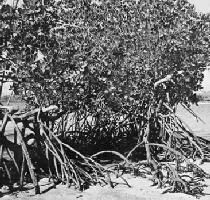
Tropical Mangrove trees are subject to daily inundation by the tide.
The trees,have many prop roots partly for access to the air but also to
resist the ebb and flow ot the tide. Many different crustaceans (shrimps,
crabs, etc) and molluscs (oysters and sea-snails) live amongst the roots.
The Crab-eating Monkeys live in the mangroves, spending their time
in the trees during high tide but coming down to search for food when the
tide goes out. They will even swim in the pools when they are hunting food.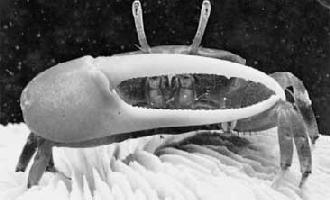
The Fiddler Crab, which has one claw larger than the other, lives
in the mangrove swamps, in the parts nearest the sea. The huge claw, which
is often coloured, is waved about to attract the female.
The Fishing Cat lives in the mangrove swamps and river-banks of South
East Asia. Unlike some other cats, it does not dislike water. It feeds
on fish, crustaceans and molluscs. It will also catch small mammals, birds,
frogs and insects. Although it has been seen to scoop fish up out of the
water, there is some dispute as to whether it really swims
Long Beaks for Catching Shellfish
Many waders, especially herons and ibises, live in the mangrove swamps. With their long beaks they are able to probe the mud and shallow water where they find plenty of crustaceans and molluscs. Cormorants, which swim off-shore, are specialized fishers, diving from the surface for their food. Also living in the mangroves are hawks and eagles, some of which are exclusively fish-eaters; others feed on other mangrove-dwelling animals. Each species has its own technique for catching fish. Some swoop down on fish swimming near the surface, others dive under the water, as the cormorant does.
Fish, Crustaceans and Molluscs
Mullet, Archer Fish and Mud Skippers are common in the mangrove swamps. Around the trees in the mud there are a variety of molluscs which include species related to the oyster, as well as many other bivalve molluscs.
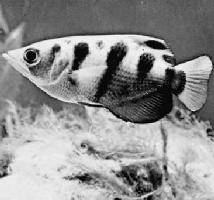
The Archer Fish lives in India and South-East Asia and "shoots"
insects. It squeezes a jet of water out of its mouth aimed at the insects
which then fall into the water and are seized by the fish. The Archer Fish
can hit a target over one metre away, by closing its gill flaps compressing
its mouth and tongue to form a tube, and squirting the water out and insects.
Although it has been seen to scoop fish up out of the water, there is some
dispute as to whether it really swims.
Above the high-tide line in the mangrove trees the Weaver Ants and many
other insects live. One of the few amphibians which can tolerate saltwater
also lives in the mangrove swamps- the Crab-eating Frog.
Slithering through the Trees
The Amethyst Python (which may be up to 6.5 metres long) lives in the
mangrove swamps on the coasts of the Philippines, the 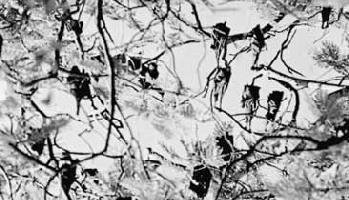 Indonesian
islands and northern Australia. This species is harmless to Man and feeds
mostly on birds. More dangerous to Man is the mangrove snake which occurs
in almost the same area.
Indonesian
islands and northern Australia. This species is harmless to Man and feeds
mostly on birds. More dangerous to Man is the mangrove snake which occurs
in almost the same area.
Flying Foxes or fruit-bats are widespread in the tropics and may
also be found in the mangrove swamps. In Central America there are fish-eating
bats which can catch surface swimming fish with their claws.
While it mostly feeds on birds, it has a bite which can kill a man.
Return to Mirror Magazine contents
![]()
Please send your comments and suggestions on this web site to
info@suntimes.is.lk or to
webmaster@infolabs.is.lk